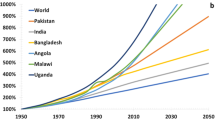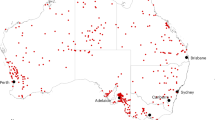Abstract
Millennium Development Goals (MDGs) have passed their target year of 2015 and are followed by Sustainable Development Goals (SDGs). One of the MDG targets was halving the population without sustainable access to safe drinking water. It was the first target achieved in the long history of internationally agreed global targets on drinking water. However, a simplified monitoring indicator could have led to the mistaken conclusion that the MDG target on ‘safe’ drinking water had actually been achieved. We show that the major contributors to the achievement of the MDG target were China and India and that the increase in the percentage of population with access to improved sources was closely associated with economic development in most nations during 1990–2015. We expect that a synergetic relationship between drinking water access and economic development will be consistently true for most nations in the current SDG Target 6.1, which aims to secure safe and affordable drinking water for all.
This is a preview of subscription content, access via your institution
Access options
Access Nature and 54 other Nature Portfolio journals
Get Nature+, our best-value online-access subscription
$29.99 / 30 days
cancel any time
Subscribe to this journal
Receive 12 digital issues and online access to articles
$119.00 per year
only $9.92 per issue
Buy this article
- Purchase on Springer Link
- Instant access to full article PDF
Prices may be subject to local taxes which are calculated during checkout


Similar content being viewed by others
Data availability
The datasets analysed during the current study are available from World Bank Open Data (https://data.worldbank.org/) and WHO/UNICEF JMP Data (https://washdata.org/data). The authors declare that all the data supporting the findings of this study are included in its Supplementary Data Set.
References
Oki, T. & Kanae, S. Global hydrological cycles and world water resources. Science 313, 1068–1072 (2006).
Fukuda, S., Murakami, M., Noda, K. & Oki, T. How achieving the millennium development goals increases subjective well-being in developing nations. Sustainability 8, 189 (2016).
Oki, T., Yano, S. & Hanasaki, N. Economic aspects of virtual water trade. Environ. Res. Lett. 12, 1–6 (2017).
Flörke, M., Schneider, C. & McDonald, R. I. Water competition between cities and agriculture driven by climate change and urban growth. Nat. Sustain. 1, 51–58 (2018).
Resolution Aadopted by the General Assembly on 28 July 2010, A/RES/64/292 2–3 (UN, 2010).
WHO in Official Records of the World Health Organization No. 95, 42 (WHO, 1959).
Lenton, R. L., Wright, A. M. & Lewis K. Health, Dignity, and Development: What Will It Take? (Earthscan, London & Sterling, VA, UK and USA, 2005).
Resolution Adopted by the General Assembly: United Nations Millennium Declaration 55/2 (UN, accessed 1 June 2017); http://www.un.org/millennium/declaration/ares552e.htm
Millennium Development Goals Indicators (UN, accessed on 1 December 2017); http://mdgs.un.org/unsd/mdg/Default.aspx
WHO/UNICEF Joint Monitoring Programme. Progress on Drinking Water and Sanitation: JMP Update 2012 (WHO, 2012).
UN The Millennium Development Goals Report 2015 (UN, 2015).
Sustainable Development Knowledge Platform (United Nations, accessed 1 June 2017); https://sustainabledevelopment.un.org/
UN. Transforming Our World: The 2030 Agenda for Sustainable Development: Resolution adopted by the General Assembly on 21 October 2015, A/RES/70/1 (UN, 2015).
Dieterich, B. H. & Henderson, J. M. Urban Water Supply Conditions and Needs in Seventy-Five Developing Countries (World Health Organization, Geneva, Switzerland, 1963).
WHO Community Water Supply and Wastewater Disposal (Mid-Decade Progress Report) A29/12 (WHO, 1976).
UN Report of the United Nations Water Conference (E/Conf. 70/29) 14–16 (UN, 1977).
UN Resolutions and Decisions Adopted by the General Assembly during its Thirty-Fifth Session 101 (UN, 1981).
WHO Drinking-Water and Sanitation, 1981–1990, A Way to Health (WHO, 1981).
WHO, UNICEF Primary Health Care, Report of the International Conference on Primary Health Care (WHO, 1978).
WHO The International Drinking Water Supply and Sanitation Decade, Review of National Baseline Data, as at 31 December 1980, Annex1 (WHO, 1984).
UN Achievement of the International Drinking Water Supply and Sanitation Decade 1980–1990 A/45/327 (UN, 1990).
Diamant, B. Z. Assessment and evaluation of the international water decade. J. R. Soc. Promo. Health 112, 183–188 (1992).
OECD-DAC. Shaping the 21st Century: The Contribution of Development Co-operation (OECD DAC, 1996).
WSSCC. Vision 21: A Shared Vision for Hygiene, Sanitation and Water Supply and A Framework for Action (WSSCC, 2000).
Manning, R. Using Indicators to Encourage Development Goals: Lessons from the Millennium Development Goals (Danish Institute for International Studies, 2009).
Vandemoortele, J. The MDG Conundrum: Meeting the Targets Without Missing. Point. Dev. Pol. Rev. 27, 355–371 (2009).
Fukuda-Parr, S., Greenstein, J. & Stewart, D. How should MDG success and failure be judged: faster progress or archiving the targets? World Dev. 41, 19–30 (2013).
Langford, M. & Winkler, I. Muddying the water? Assessing target-based approaches in development cooperation for water and sanitation. J. Hum. Dev. Capabil. 15, 247–260 (2014).
Moss, T. What next for the millennium development goals?. Glob. Policy 1, 218–220 (2010).
Easterly, W. How the millennium development goals are unfair to Africa. World Dev. 37, 26–35 (2009).
Clemens, M. & Moss, T. What’s Wrong with the Millennium Development Goals? (Center for Global Development Brief, 2005); https://www.cgdev.org/sites/default/files/3940_file_WWMGD.pdf
Fukuda-Parr, S., Lawson-Remer, T. & Randolph, S. Fulfilling Social and Economic Rights (Oxford Univ. Press, New York, NY, USA, 2015).
Pineo, C. S. & Subrahmanyam, D. V. Community Water Supply and Excreta Disposal Situation in the Developing Countries (World Health Organization, Geneva, Switzerland, 1975).
WHO/UNICEF Joint Monitoring Programme Water Supply and Sanitation Sector Monitoring Report 1993, Sector Status as of 31 December 1991 (WHO/UNICEF, 1993).
WHO/UNICEF Joint Monitoring Programme Global Water Supply and Sanitation Assessment 2000 Report (WHO/UNICEF, 2000).
WHO/UNICEF Joint Monitoring Programme Core Questions on Drinking-Water and Sanitation for Household Surveys (WHO/UNICEF, 2006).
WHO/UNICEF Joint Monitoring Programme Drinking Water: Equity, Safety and Sustainability (WHO/UNICEF, 2011).
WHO/UNICEF Joint Monitoring Programme JMP Technical Task Force Meeting on Monitoring Drinking-Water Quality (WHO/UNICEF, 2010).
Onda, K., LoBuglio, J. & Bartram, J. Global access to safe water: accounting for water quality and the resulting impact on MDG progress. Int. J. Environ. Res. Public Health 9, 880–894 (2012).
Johri, M., Chandra, D., Subramanian, S. V., Sylvestre, M. & Pahwa, S. MDG 7c for safe drinking water in india: an illusive achievement. Lancet 19, 1379 (2014).
WHO/UNICEF Joint Monitoring Programme WASH in the 2030 Agenda, New Global Indicators for Drinking Water, Sanitation and Hygiene (WHO/UNICEF, 2017).
WHO/UNICEF Joint Monitoring Programme Progress on Drinking Water, Sanitation and Hygiene 2017, Update and SDG Baselines 24 (WHO/UNICEF, 2017).
Official website of WHO/UNICEF JMP (WHO/UNICEF, accessed 1 January 2017); https://washdata.org/
Toubkiss, J. Costing M. DG Target 10 on Water Supply and Sanitation: Comparative Analysis, Obstacles and Recommendations (World Water Council, 2006).
WHO/UNICEF Joint Monitoring Programme Progress on Sanitation and Drinking Water: 2010 Update (WHO/UNICEF, 2010).
World Bank World Development Report 1992, Development and Environment (Oxford University Press, 1992).
Anderson, E. & Langford, M. A Distorted Metric: The MDGs and Sstate Capacity (University of Oslo Faculty of Law Research, 2013).
World Bank Open Data (World Bank, accessed 1 December 2017); https://data.worldbank.org/
Acknowledgements
This work was supported by Grants-in-Aid for Scientific Research of Japan Society for the Promotion of Science (KAKENHI; 16H06291 (T.O.) and 17k17662 (K.N.)).
Author information
Authors and Affiliations
Contributions
S.F. designed the study, conducted data analysis and wrote the paper with contributions from all authors. K.N. and T.O. supervised and supported the research.
Corresponding author
Ethics declarations
Competing interests
The authors declare no competing interests.
Additional information
Publisher’s note: Springer Nature remains neutral with regard to jurisdictional claims in published maps and institutional affiliations.
Supplementary information
Supplementary Information
Notes 1–4, Supplementary Figures 1–6, Supplementary Tables 1–12, Supplementary References 1–44
Supplementary Dataset
Data for Fig. 2 in the main text and Supplementary Note 4 — spreadsheets providing 1990 and 2015 data of GDP per capita, population and water coverage for 139 countries
Rights and permissions
About this article
Cite this article
Fukuda, S., Noda, K. & Oki, T. How global targets on drinking water were developed and achieved. Nat Sustain 2, 429–434 (2019). https://doi.org/10.1038/s41893-019-0269-3
Received:
Accepted:
Published:
Issue Date:
DOI: https://doi.org/10.1038/s41893-019-0269-3
This article is cited by
-
Antimicrobial silver nanoparticles for water disinfection: a short review on recent advances
Nanotechnology for Environmental Engineering (2024)
-
Sensitivity of subregional distribution of socioeconomic conditions to the global assessment of water scarcity
Communications Earth & Environment (2022)
-
Cyclodextrin-based adsorbents for the removal of pollutants from wastewater: a review
Environmental Science and Pollution Research (2021)
-
Meeting global drinking water needs
Nature Sustainability (2019)
-
Global water policy and local payment choices in rural Africa
npj Clean Water (2019)



